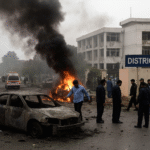In late July 2025, a devastating cloudburst struck Pakistan’s Gilgit-Baltistan region, particularly around Babusar Top and parts of the Karakoram Highway. The resulting flash floods and landslides caused widespread destruction — sweeping away vehicles, tearing through roads, and isolating hundreds of tourists. Communication blackouts due to mobile and internet outages further hampered rescue operations.
Authorities reported at least 14–15 road blockages, destruction of approximately 8 km of connecting roads, and a tragic human toll: five confirmed deaths (including four tourists), around fifteen people missing, and nearly 200 individuals stranded in the affected zone.
Pakistan Army’s Role in Rescue & Relief
Helicopter Evacuations
Responding swiftly, the Pakistan Army — particularly its Force Command Northern Areas — led the air rescue missions. Military helicopters evacuated stranded tourists near Babusar Top, delivered ready-to-eat meals, transported the injured to medical facilities, and recovered the bodies of the deceased for respectful transport.
Road Clearance & Infrastructure Support
Six dedicated companies were mobilized to deploy heavy excavators and clear debris from blocked roads. The operations covered not only Babusar but also surrounding routes like Lal Parhi and Tatta Pani. The National Highway Authority (NHA) and Frontier Works Organization (FWO) were ordered to expedite rehabilitation efforts, restoring vital connections for emergency access and tourism routes.
Medical & Emergency Infrastructure
A 24/7 emergency control room was established in the Diamer District to coordinate rescue, logistics, and information dissemination. Medical personnel from both the army and local health agencies provided aid on-site, ensuring critical care reached injured individuals despite terrain challenges.
Federal & Local Government Response
Emergency Measures & Coordination
The Gilgit-Baltistan government declared a formal state of emergency for the flood-affected areas. The National Disaster Management Authority (NDMA) issued alerts for landslides and flash floods and facilitated coordination between district officials and military units.
Tourists and local travelers were advised to avoid Babusar Road until further notice. Evacuations were carried out to designated safe zones to prevent further loss of life.
Leadership & Oversight
At the national level, both President Asif Ali Zardari and Prime Minister Shehbaz Sharif called for immediate and comprehensive relief efforts. They emphasized close coordination among the NDMA, provincial administrations, and the Pakistan Army to ensure swift action and efficient delivery of assistance.
Community & Local Contributions
Amid the crisis, local communities became the unsung heroes. Residents of Sadpara, Skardu, and surrounding villages opened their homes and community spaces — including an Imambargah — to shelter stranded tourists. They provided food, warm bedding, and emotional support until formal rescue units arrived. This grassroots compassion received widespread praise and demonstrated the power of community resilience in times of disaster.
Overview of Impact & Response Efforts
| Category | Details |
|---|---|
| Fatalities | 5 confirmed (4 tourists, 1 local resident) |
| Missing Persons | Approximately 15 reported missing |
| Stranded Tourists | Nearly 200, later housed in hotels and guesthouses in Chilas |
| Road Damage | 14–15 points blocked, 8 km of roads destroyed |
| Rescue Teams | Pakistan Army, NDMA, district administration, Rescue 1122 |
| Relief Services | Helicopter evacuations, food aid, medical support, road clearance |
| Emergency Facilities | 24/7 control room, safe-zone advisories, multi-agency coordination |
Evaluation of Response: Strengths & Challenges
Strengths
-
Rapid aerial operations enabled timely rescue of tourists from dangerous, remote terrain.
-
Coordinated ground clearance reconnected vital routes despite major landslides.
-
Federal and provincial alignment ensured quick mobilization of resources and funding.
-
Community participation showcased solidarity, compassion, and local leadership in crisis.
Challenges
-
Communication breakdowns due to mobile/internet blackouts delayed information sharing.
-
Difficult terrain and unstable weather slowed down ground rescue and road repairs.
-
Initial delays in some rescue efforts raised concerns among survivors about early-stage coordination.
Conclusion
The catastrophic floods around Babusar Top tested Pakistan’s disaster preparedness and response capacity. While the terrain and weather posed immense challenges, the combined efforts of the Pakistan Army, NDMA, local administrations, and everyday citizens ensured hundreds of lives were saved and further disaster was averted.
This event is a powerful reminder of the need to improve early warning systems, strengthen infrastructure resilience in high-altitude zones, and foster community-level disaster education. The Babusar response though hard-earned has shown the value of unity, speed, and strategy in protecting lives during national emergencies.










